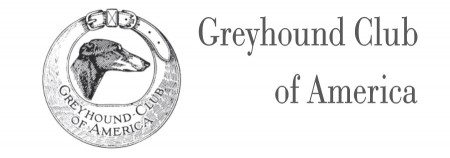I would like to introduce myself as the person writing the Greyhound column for the first time. My name is Patti Clark and I have been involved in various aspects of the sport of dogs since 1978. My interest in the Greyhound began almost 35 years ago and in 1991 I co-bred my first greyhound litter under the prefix, Willomoor with June Matarazzo. Professionally, I have been a clinical microbiologist, laboratory administrator, professor, and dog handler, juggling these careers simultaneously. I have recently retired from the role of full time laboratorian and have some time to write about things I love, so let’s get to it!
People often ask why is a greyhound shaped the way it is and why do they look like baby dinosaurs when they themselves are babies? Here is why. The outline of a greyhound shows us the parts and pieces that allow the Greyhound to do his unique job of hunting and chasing prey of various sizes, speed and over varied terrain for long periods of time. The parts and pieces must come together into a single unit that speaks to balance, symmetry, and oneness.
That’s a mouthful but let’s break it down a bit. We know from various writings dating back to the ancient Greeks that the greyhound was used to course a wide variety of game. We know Greyhounds were found inhabiting areas of sand, mountain, rocky hills and terrain in between. We see in canine art through the centuries, that the dogs were used in these places and for these purposes. How fortunate we are to have this documentation of an ancient breed!
So, back to the outline, so smooth and with seamless transitions from head to tail and brisket to loin, often described as the shape of a pair of S curves. Our standard calls for a slight rise over the loin that is both a curvature of the spine and muscling. This configuration allows for the contraction and expansion of the double suspended gait acting almost as a hinge. No breed does this better in my opinion.
A deep chest that allows for good lung capacity and tuck up to the loin that allows the rear and front legs to pull up tightly under the body and then explode out propelling the greyhound forward. A functional Greyhound has a strong neck which transitions into shoulder allowing for capture of game on the move. This neck is not only functional but adds to the elegance of this breed with its length and arch. At the other end, a long sweeping tail that curves slight upward on the move, completes the outline. Add to this, long legs under the body, forelegs that are as long from the elbow to the ground as the length from the withers to the elbow and a strong moderately -angled rear to match.
Hopefully, you can see a picture of an elegant, functional, well-muscled Greyhound in your mind from this description.
We will explore many other features of the greyhound in the future but hopefully this has whetted your appetite to know more about this beautiful, hunting sighthound.
